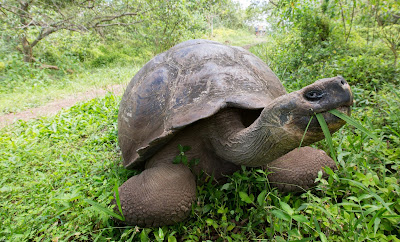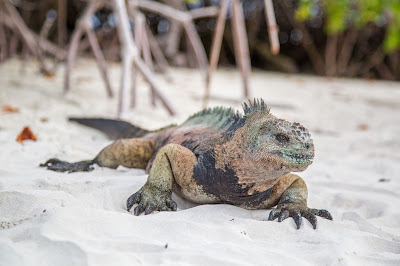We began our last day on the island with a relatively late start of 8:30AM. Some of us tried a local coffee shop; sustainably-grown coffee (and chocolate) is a significant crop in the Galapagos and Ecuador in general.We walked through the town of Santa Cruz on our way to the Charles Darwin Research Station:
We also walked by a very elaborately decorated above-ground cemetery:
After about 15 minutes, we arrived at the Research Station. Established in 1959 (the 100th anniversary of the publication of The Origin of Species), this facility works to protect the terrestrial and marine biodiversity of the Galapagos archipelago.
Our guide Marlon led us through the exhibits. Some discussed general information about the biology of the islands. Other exhibits taught us about the restoration efforts of the Research Station to control invasive species and protect the endemic wildlife.
The Station is best known for its tortoise breeding program. Tortoises are bred and raised in captivity for 3 years in preparation for being returned to the wild. These efforts have been quite successful, with the hope that in another decade or two, the wild tortoise population will reach its full capacity on all of the islands.
The breeding program affords the opportunity to see very young turtles:
We were also able to closely observe adults of several species that we had not seen in the wild:
The station also afforded the opportunity to observe a variety of birds and a land iguana (which we did not see in the wild):
One of the strangest exhibits had to do with Lonesome George, a tortoise who lived at the Research Station. George was famous as a symbol of conservation and the need to protect endangered species. George was the last surviving Pinta Island tortoise. After he died in 2012, the Station sent his body to the U.S. for examination and preservation. He is now housed in a special room at the Station. Entrance is limited to about a dozen people at a time. You start by spending two minutes in a climate acclimation room, which features a germ-killed UV light. You then enter the display room, where George stands behind plexiglass as the sole item in the room. You exit via another two minute acclimation room. The display reminded me of Lenin's tomb and struck us all as a bit odd.
As we walked back into town, we were all quite aware that this was our last day on the islands. We were sure to pause for final looks at the unique creatures and culture of the islands:
We boarded our bus, stopping at a supermarket to stock up on local hot sauce, chocolate, and coffee before our departure. This also afforded the opportunity to look at Santa Cruz bay one last time:
Santa Cruz was definitely the most developed island we visited, with paved roads, traffic lights, some traffic, and many stores geared toward tourists.
Our final stop on our journey was to view a forest of scalesia tree. This was particularly gratifying since it was these trees that we all had worked to help replant during our visit to the reforestation center. The forests were filled with trilling birds.
Some tears were shed as we said goodbye to Marlon, our guide and constant companion during our visit, and waved goodbye to the islands that had shared so much beauty with us:
We rode the bus to the far end of the island for a short ferry ride to Baltra, our fifth island. We rode another bus to the airport. We took time to repack for our long journey home:
Our 25 hour journey back to Henniker proceeded in total by bus, ferry, bus, plane, overnight plane, train, plan, and finally the van ride back to school. (Thank you to Mark Mitch for driving us!)
Thank you all for reading this blog! In the future, we will be posting our travel writing and other reflections, as well as additional photos and videos documenting our journey.
Everyone had a wonderful and transformative experience. Every student embraced the experience for all it was worth and always conducted themselves with respect and enthusiasm for this unique opportunity. We thank everyone who made this trip possible, especially the New England College Travel Away Program for funding our trip.
- Eric J. Simon, Ph.D.
































































